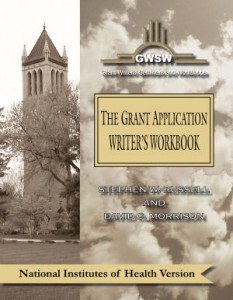This important question was addressed in a recent detailed analysis of published manuscripts (Acad Med. 2015 Dec;90(12):1720-5 J.P.Wisdom, H. Riley and N. Myers). Based on their comprehensive analysis, these authors have formulated 10 specific recommendations for what individual applicants and their affiliated institutions need to do in order to enhance the probability of success in the relatively time-consuming activity of proposal preparation. Perhaps not surprisingly, each of these 10 relatively logical and straightforward recommendations are exactly those that are included in each of our versions of The Grant Application Writer’s Workbook (NIH version, NSF version, USDA version and Any Agency version). For example, in considering the content of the NSF workbook and its relationship to the recommendations spelled out in this publication, these include: 1) identify appropriate funding opportunities (Chapter 3 “How to Choose the Appropriate Funding Opportunity & NSF Granting Mechanism for Your Idea”); (2) use key proposal components to persuade reviewers of project significance and feasibility (Chapter 8: “How to Maximize Your Application’s Programmatic Relevance to NSF”); (3) describe proposed activities persuasively, clearly, and concisely (Chapter 7 “Overview and Ob-jectives Section; Template for Creating a Bullet Outline”); (4) seek critical review and feedback from knowledgeable colleagues”) (Chapter 19 “Pre-Submission Review of Intellectual Merit and Broader Impacts”); and (5) ensure that budgets are reasonable (Chapter 14 “Budget and Budget Justification”)
.
Relevant chapters for the other 5 recommendations described in this publication include (6) develop a timeline for the proposal process (both the time required for preparation and an appropriate timeline for execution of the activities); (7) establish a study design that is simple, logical, feasible, and appropriate for the research questions; (8) select a novel, high-impact project; (9) conduct an exhaustive literature review; and (10) consider the inclusion of interdisciplinary collaborations. Each of these is also discussed in our series of The Grant Application Writers’ Workbook, as well as in our institutionally-sponsored “Write Winning Grant Proposals” one-day seminars. Importantly, each of these workbooks is updated periodically to incorporate key changes that have been instituted by funding agencies in terms of changes in instructions to applicants, policies for preparation of applications, etc. Information on each of these workbooks may be found by clicking on the tab above entitled “Workbooks”. Specifically, the Table of Contents, and copies of information presented in Sample Pages for several chapters of each Workbook are included.
Of equal interest and importance, the authors conclude that “further institution-level development and interventions to support faculty grant writing success are warranted”. Not surprisingly, this is the focus of our one- day “Write Winning Grant Proposals” seminar and our comprehensive workshops, the latter of which guide a group of faculty through the entire process of writing a competitive grant application, from idea development through critiquing of the entire written grant application. These programs have been offered to academic institutions and research institutions throughout the U.S. since 1994.
ACCESS EARLIER POSTS
RELATED TO:
GWSW Workbooks offer comprehensive, step-by-step instruction for creating proposals for a variety of funding agencies.

